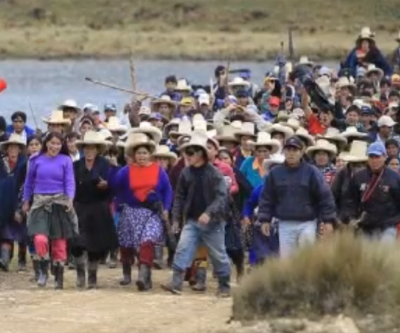Peru lifts state of emergency over Conga mine

The Peruvian government confirmed it will end Monday a state of emergency imposed in early July in the country’s northern region, where violent protests against Newmont Mining’s (NYSE:NEM) controversial $4.8 billion Conga project left five dead and dozens injured.
Local authorities quoted by local newspaper El Comercio said security forces would remain on alert to guard against unrests. Hundreds of soldiers have been deployed in the three provinces to quell protests against the proposed copper-gold project.
The state of emergency suspended the right of assembly and other civil liberties in the three northern provinces of Celendin, Cajamarca and Bambamarca.
Opponents of Conga fear for the locals’ water supplies, but Newmont is revising its plans in consultation with residents as it has repeatedly said it remains focused on “the construction of water reservoirs, the security and safety of the community, our employees and contractors is our first priority.”
But the Denver-based company has a tough road ahead, as an opinion poll divulged a few days ago showed that about 4 in 5 locals are opposed to Conga.
Pollster Ipsos-Apoyo said that 78% reject the project, while only 15% approve. The rest had no opinion.
Conga is being developed by Minera Yanacocha, of which Newmont Mining, the world’s number two gold producer, holds a 51.35% interest and Compañía de Minas Buenaventura a 43.65%. The IFC owns the remaining stake.
Newmont had said it hoped to begin production either in 2014 or 2015, generating between 155 and 235 million tons of copper a year at the site, provided it gets permission from the Peruvian government.
The U.S.-based miner had proposed four high altitude lake reservoirs be substituted with artificial lakes, which triggered massive strikes and protests that ended up forcing Newmont to suspend the project in November last year and the Peru’s government to declare a state of emergency in the area.
Political minefield
The contentious Conga, which was to begin production in early 2015, was designed basically as an extension of the Peru’s Buenaventura’s nearby Yanacocha, Latin America’s largest gold mine, which is approaching the end of its life.
Conga is capable of producing up to 350,000 ounces of gold and 120 million pounds of copper per annum with a 19-year life of mine.
The project is the largest ever single private investment in the country and has turned into a political minefield for the Humala administration with many in the opposition and within his own party calling for drastic changes to his handling of the most recent protests.
But negative reactions to mining projects are not unusual in Peru. Large-scale protests against exploration and extraction activities have swept the country in recent years, making of social conflicts the main risk for investors in the local industry.
Peru’s extractive sector, which accounts for some 60% of the economy, is expected to bring the country $50 billion in future investment over the next decade.
(Image: Opponents to Conga march. NewsLIVE)
Related:
{{ commodity.name }}
{{ post.title }}
{{ post.date }}




2 Comments
hugo
Strange. In an interview with Peruvian journalist Rosa Maria Palacios, Roque Benavides stated that the proposed mine would only produce copper, no gold. The mine life would be of 6 yrs with only a 10% margin. Palacios then asked why such a great push for Conga if its financials appeared lousy.
MINING.com Editors
http://www.newmont.com/sites/default/files/u87/Conga_FactSheet.pdf